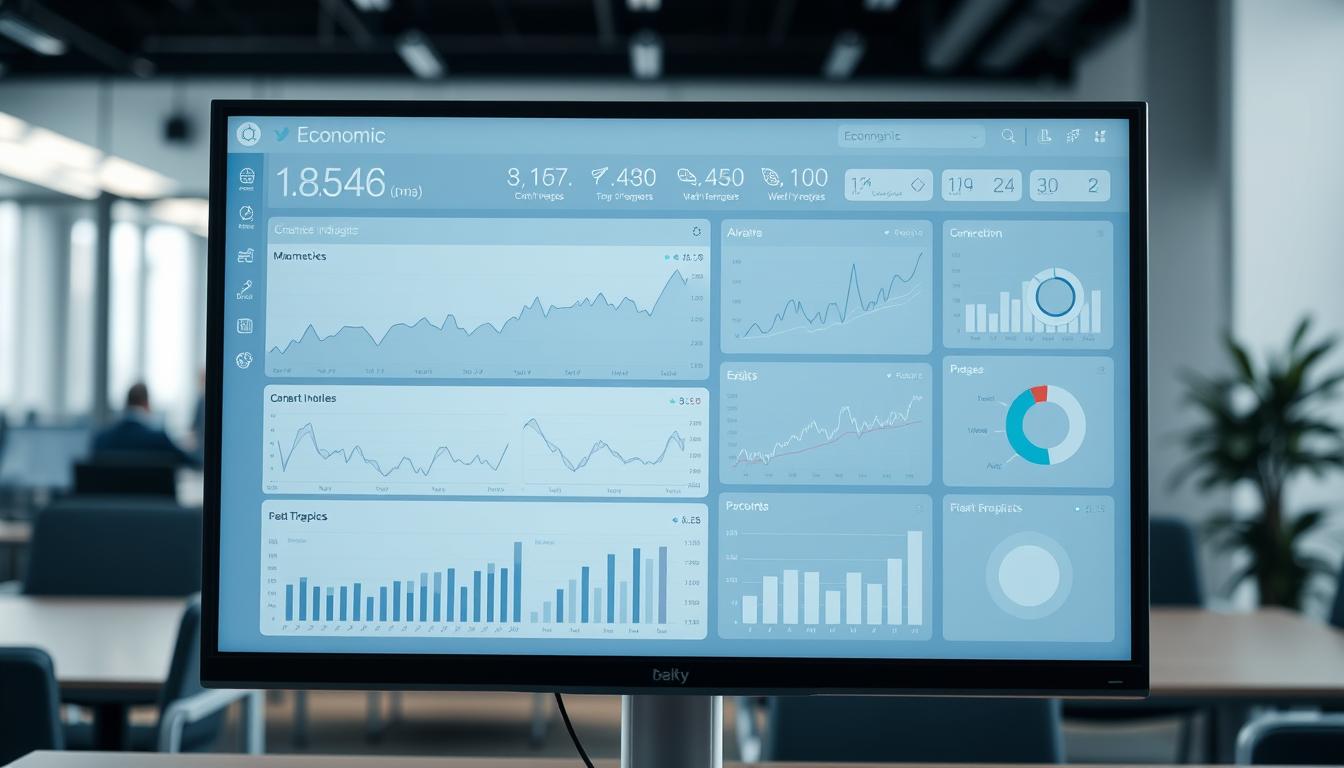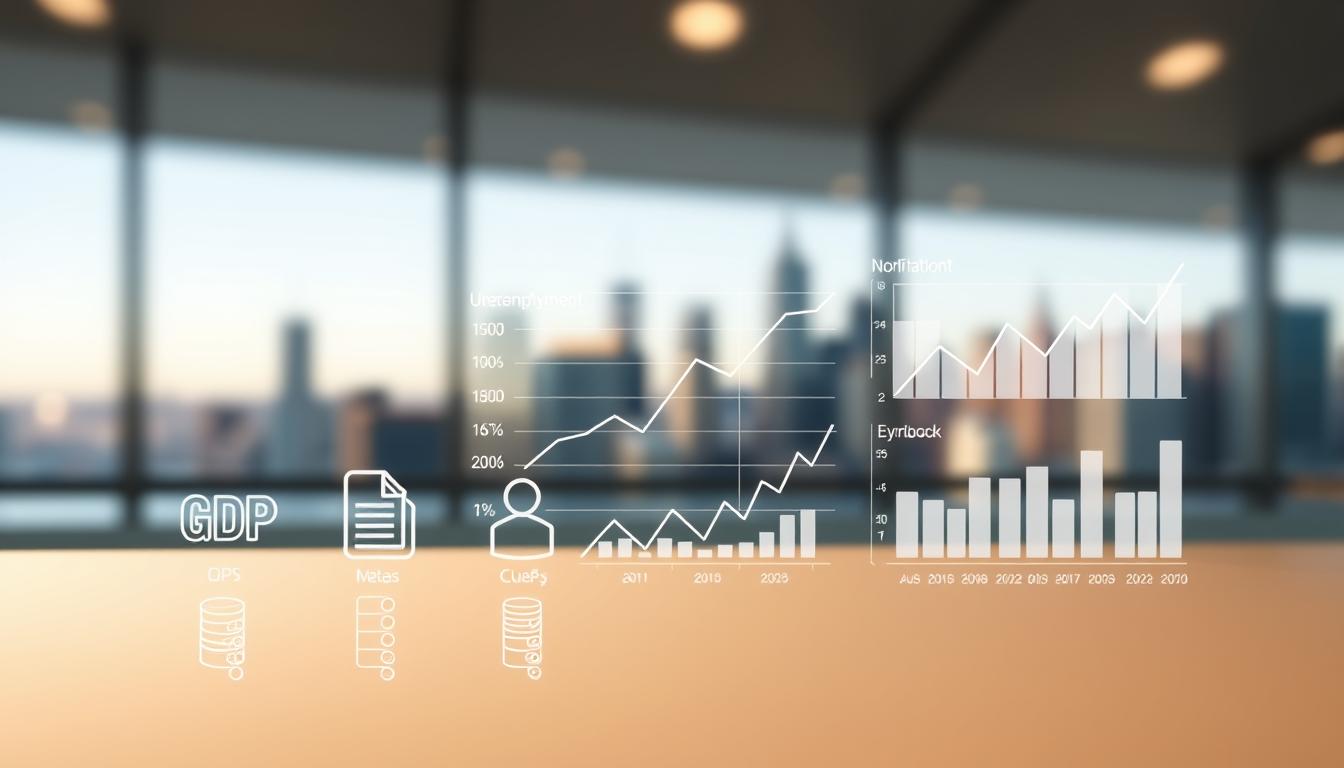Economic indicators are crucial for understanding a country’s economy. They help us see how healthy the economy is and what might happen next in the market. Important ones like the Consumer Price Index (CPI), Gross Domestic Product (GDP), and unemployment rates give us a peek at economic changes. Knowing about these indicators helps investors and policymakers make smart choices in a complex economy.

GBTI Visa Gold Card

What Are Economic Indicators?
Economic indicators are vital data points that show different aspects of an economy’s performance. They give us insights into an economy’s health and measure its overall success. Knowing what economic indicators mean helps us understand their importance in economic analysis.
Anúncios
Definition and Importance
Economic indicators include a variety of statistical data used by economists and policymakers to understand economic trends. These indicators fall into three types: leading, lagging, and coincident. Recognizing their value helps key players make decisions based on current data. For example, investors and businesses use these indicators to know market trends and plan their future steps.
Anúncios
Role in Economic Analysis
In analyzing the economy, these indicators are key for examining economic stability and growth. Analysts look at these signposts to spot trends and changes that might impact investments and policy making. With this data, governments and groups can foresee economic movements. This makes the indicators crucial for planning what comes next.

Types of Economic Indicators
Economic indicators come in three types: leading, coincident, and lagging. Each has a special role in assessing the economy’s health and its future direction.
Leading Indicators
Leading indicators, including stock prices and new orders, offer early hints about the economy’s future. They change before the overall economy does. This makes them useful for predicting what might happen next.
Coincident Indicators
Coincident indicators show us the economy’s current state. Examples are GDP and employment levels, which happen at the same time as the events they track. They help policymakers understand what’s happening right now.
Lagging Indicators
Lagging indicators provide information after events have happened. They include things like unemployment rates and the Consumer Price Index (CPI). While they confirm trends, they’re not helpful for predicting. They can slow down decision-making because of their delayed nature.
Leading Indicators
Leading indicators are key to predicting the economy’s future. They help businesses and investors make choices by spotting early economic trends. By knowing which indicators to watch, people can track market changes and how consumers might act.
Examples of Leading Indicators
There are important indicators that signal economic shifts. Some of these include:
- Yield curve
- Consumer durable goods orders
- Manufacturing output
Such indicators hint at what’s coming in the economy. For instance, more orders for long-lasting goods show businesses feel optimistic. They expect people to buy more, which usually means the economy is getting stronger.
How Leading Indicators Help Predict Economic Trends
Leading indicators are vital for guessing where the economy is headed. By looking at changes in these numbers, investors and analysts try to predict growth or decline. Watching things like how much is being made or how confident consumers are helps them see where the market might go. However, the economy can be unpredictable, so they need to be careful. Understanding these indicators correctly can lead to better decisions in a changing economy.
Coincident Indicators
Coincident indicators show us how an economy is doing right now. They change at the same time as the economy, giving a clear picture of the current situation. They are key for smart economic choices and understanding.
Overview of Coincident Indicators
We look at important things like Gross Domestic Product (GDP) and job rates to understand coincident indicators. These indicators help us see if the economy is doing well or facing problems. For instance, a rising GDP means the economy is growing. But, if fewer people are working, it could mean trouble.
The Role of GDP and Employment Levels
GDP is crucial for seeing how the economy is doing. It shows us growth trends and how productive things are. Job rates are just as important because they tell us if the workforce is strong. High job rates mean the economy is buzzing. But if those rates drop, it’s a sign things might slow down. These insights guide us in making policies that meet the economy’s needs.
Lagging Indicators
It’s key to grasp what lagging indicators are when studying the economy. They only become noticeable after certain economic events happen. These indicators help confirm trends, playing a crucial role in understanding the economic scene. CPI and unemployment rates are especially significant.
Understanding Lagging Indicators
Lagging indicators are about confirming past trends, not predicting what will happen next. They show economic data after events have taken place. This helps economists and policymakers understand if past decisions worked well. It’s particularly useful for getting a clear picture of the economy, especially in uncertain times.
The Significance of CPI and Unemployment Rates
The Consumer Price Index (CPI) shows how inflation affects what people can buy. When CPI goes up, it usually means prices for things are rising too. On the other hand, unemployment rates help us see if the economy is stable. A high unemployment rate can mean tough times, showing that some workers are struggling and policies might need to change.
Key Economic Indicators in the United States
Understanding the key economic indicators in the USA is vital. It helps us know the economy’s health. Key indicators include real GDP, labor market data, and inflation reports. These influence economic policies and strategies for businesses.
Real Gross Domestic Product (GDP)
Real GDP measures economic output while adjusting for inflation. It shows how the economy is performing. Plus, it gives insight into living standards and consumer well-being in the USA. A rising real GDP shows economic stability. A fall suggests a possible downturn.
Labor Market Data and Unemployment Rates
The Bureau of Labor Statistics shares data on employment and unemployment rates. These numbers help track job growth trends. They also check economic stability. A strong labor market goes hand in hand with a vibrant economy. On the other hand, rising unemployment can mean economic troubles.
Inflation Reports
Inflation reports, especially the Consumer Price Index (CPI), track price changes for goods and services. They guide government policies and business strategies on cost management. Keeping an eye on inflation helps businesses stay competitive. It also lets consumers keep their buying power.
The Stock Market as an Economic Indicator
The stock market tells us how the economy is doing. Happy investors push up stock prices, showing a strong economy. But if prices fall, it might mean trouble ahead. Knowing how stocks move helps us figure out the economic picture.
Looking closely at the stock market helps us understand the economy’s health. A rising market means good earnings, more shopping, and more jobs. This growth boosts investor confidence. Stocks can show us where the economy might be heading.
However, the stock market isn’t perfect. It can be unpredictable, moving up or down because of reasons not linked to the economy’s core health. Tricks and guesses can make the market seem healthier than it really is. It’s important to know these limits when using the stock market to read the economy.
Advantages and Disadvantages of Economic Indicators
Economic indicators are key for making smart decisions. They help us understand economic trends and predict future finances. But, they’re not perfect and have downsides too.
Pros of Using Economic Indicators
Economic indicators improve how we make decisions with data. Available to everyone, they help us see how the economy is doing. Here are some benefits:
- They give us detailed data to predict market trends.
- They offer a way to check how different sectors are doing.
- They let us compare past and present data for better insights.
Cons of Relying on Economic Indicators
But, economic indicators have their limits. It’s important to know these downsides:
- There’s a risk of reading the data wrong and making mistakes.
- They can simplify complex economic details too much.
- Forecasts might not include sudden changes, making them unreliable.
Interpreting Economic Indicators
Understanding economic indicators involves more than meets the eye. It’s about knowing the historical context of the data. Economic indicators on their own can’t fully explain how the economy is doing. They need to be looked at against past trends.
By studying history, analysts can spot patterns and stages of the economic cycle. This knowledge helps predict future trends.
Using benchmark comparisons is key in economic analysis. Analysts match current data with set standards, like the Federal Reserve’s inflation target. This helps understand the real impact of economic numbers.
A detailed look at economic indicators makes policy decisions and investments more effective. Knowing how current numbers compare to benchmarks helps people make better choices in the economy.
What Is the Most Important Economic Indicator?
Many economists say GDP is key to understanding economic health. It measures all goods and services made and used in a country. This helps see how wealthy or prosperous a nation is.
Knowing about GDP and inflation helps in making smart economic choices. It’s crucial for planning and decision-making in economics.
GDP as a Key Measure of Economic Health
Gross Domestic Product, or GDP, is vital for gauging an economy. It shows the value of all goods and services made in a country within a certain time. If GDP is up, it means the economy is doing well, showing more jobs and spending.
But if GDP is not growing, it suggests the economy might be in trouble. People then worry about how stable and strong the economy is.
The Role of Inflation in Economic Strategies
Inflation, shown by things like the Consumer Price Index (CPI), affects GDP a lot. It changes how much things cost, influences investment choices, and shapes economic policies. Leaders try to keep inflation and GDP growth in balance.
This balance helps everyone—people and businesses—make better plans. It leads to a stable and growing economy.
Conclusion
Knowing about economic indicators is key to understanding and predicting market trends. This summary shows why they are important. It also explains how they are grouped into leading, coincident, and lagging indicators. Each group offers special insights that help investors and policymakers decide wisely in a changing economy.
Keeping an eye on important data, like GDP, inflation, and job rates, is vital. This data helps us get the full picture of the market and the economy’s health. It proves why these indicators are must-haves for dealing with complex situations.
In short, this conclusion stresses the value of economic indicators in making smart decisions and plans. Learning about these indicators allows people to navigate the changing economic scene better. They can make data-based and forward-looking choices.
FAQ
What are economic indicators?
Why are economic indicators important?
What are the three types of economic indicators?
Can you give examples of leading indicators?
What is the role of coincidence indicators?
How do lagging indicators help economic analysis?
What are some key economic indicators in the United States?
How does the stock market function as an economic indicator?
What are the advantages of using economic indicators?
What are the disadvantages of relying solely on economic indicators?
Why is context important when interpreting economic indicators?
What is considered the most important economic indicator?
How does inflation impact economic strategies?
Conteúdo criado com auxílio de Inteligência Artificial


